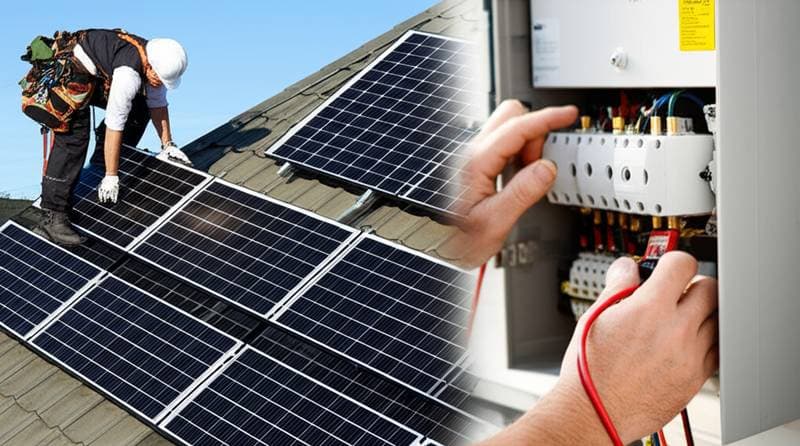Understanding DIY Solar Permissions Across States
Homeowners frequently pursue solar panel installations to decrease utility expenses and foster energy independence. Self-installation offers satisfaction, yet it involves substantial electrical and regulatory challenges. State regulations dictate permissible homeowner tasks, mandatory professional involvement, and inspection protocols.
Research local guidelines thoroughly before commencing any work. Certain states authorize homeowners to manage the entire process, provided adherence to electrical codes and successful inspections occurs. In contrast, other states demand certified professionals for high-voltage connections or roof-mounted systems.
Prioritizing Safety: Indicators for Professional Assistance
Electrical work on roofs and service panels poses severe risks, including shock, fire, or system malfunctions. Even minor errors can lead to catastrophic outcomes.
Engage a licensed electrician or solar specialist under these conditions:
- Modifications or replacements to the primary service panel are necessary.
- The residence features aluminum branch wiring, knob-and-tube systems, or circuits lacking proper grounding.
- Uncertainty exists regarding integration of the solar array with the existing breaker panel.
- Roof conditions present damage, instability, or limited access.
- Jurisdictional rules mandate professional certification for grid interconnection.
Professionals ensure accurate grounding, appropriate conductor dimensions, and adequate overcurrent safeguards. They apply precise torque to terminals with calibrated screwdrivers and utilize non-contact testers to verify voltage absence safely.
Navigating State and Local Regulations
State electrical boards or energy departments establish boundaries for homeowner-led installations. Local building authorities enforce these standards, potentially imposing stricter contractor requirements even in permissive states.
Permits typically apply to:
- Roof- or ground-based solar arrays.
- Wiring connections linking panels, inverters, and the service panel.
- Battery storage units connected to the solar configuration.
Unauthorized installations may result in utility refusal of grid access. Insurers could deny coverage for damages stemming from non-compliant work.
States Permitting Extensive Homeowner Involvement
A number of states enable homeowners to execute most installation elements, contingent upon meeting rigorous inspection criteria. Requirements generally include:
- Property ownership and primary residency.
- Compliance with the National Electrical Code and any local modifications.
- Acquisition of all relevant building and electrical permits.
- Arrangement of a conclusive inspection prior to grid connection.
Inspectors in these regions often request documentation such as manufacturer datasheets, wiring schematics, and inverter specifications to confirm code adherence.
Permissible tasks for homeowners include:
- Securing panels to the roof via approved racking hardware.
- Routing conduit and wiring from panels to the inverter location.
- Positioning disconnect switches and applying NEC-mandated labels.
Homeowners cannot provide the professional endorsement needed for utility interconnection if stipulated.
Jurisdictions with Limited DIY Participation
In various states, homeowners face constraints on self-installation scope. Individuals may install racking and panels independently but require licensed electricians for wiring completion. Grid-tied systems often necessitate certified solar contractors.
Such limitations prioritize safety, as faulty wiring or undersized breakers can provoke overheating. Incorrect inverter bonding risks ground faults that electrify conductive surfaces, heightening shock potential.
Homeowners in restricted areas can contribute through preparatory efforts:
- Removing roof debris and assessing structural soundness.
- Designing panel arrangements based on optimal azimuth and tilt for maximum efficiency.
- Preparing conduit routes to facilitate professional wiring.
- Assembling permit paperwork in collaboration with the contractor.
This collaborative method controls expenses while upholding regulatory standards.
Essential Tools and Components for DIY Installers
For states endorsing complete self-installation, assemble appropriate equipment and certified materials in advance.
Key tools encompass:
- A torque screwdriver calibrated to manufacturer torque specifications for secure connections.
- Non-contact voltage tester to identify live circuits without direct exposure.
- Wire strippers and crimpers suitable for photovoltaic cabling.
- Multimeter to measure voltage levels and confirm polarity.
- Sturdy ladder paired with a fall arrest harness for elevated work.
Select exclusively UL-listed components, including:
- Photovoltaic modules and racking compatible with your roofing material.
- Inverters incorporating ground-fault and arc-fault interruption features.
- Conductors and conduit sized correctly for the system load.
- Durable, weatherproof disconnects accompanied by permanent labels.
Securing Approval Through Inspections and Interconnections
State permission for DIY does not exempt the need for thorough inspections, which determine operational eligibility. Authorities examine:
- Conductor gauges matching breaker capacities.
- Firm panel attachments and effective roof sealing.
- Uninterrupted grounding and bonding pathways.
- Readily accessible disconnects with prominent signage.
Post-inspection approval, utilities evaluate the setup for grid integration. They might demand professional attestation or detailed schematics prior to authorizing activation.
Minimizing Hazards and Safeguarding Your System
Self-installation yields cost savings, but inadequate verification risks warranty invalidation or premature failures. Maintain comprehensive records of components and inspections. Capture images of internal wiring prior to enclosure and adhere to manufacturer-recommended torque settings.
Consult a professional for any ambiguous aspects. Solar arrays demand longevity over decades, and overlooked flaws may engender enduring dangers.
Practical Actions for Aspiring Installers
- Consult the local building department regarding permit and licensing obligations.
- Examine state solar policies via the energy office or electrical board resources.
- Inquire with your utility on residential solar interconnection protocols.
- Design the project emphasizing safety protocols, avoiding shortcuts on permits or checks.
- Arrange a pre-project evaluation of your home's electrical infrastructure by an expert.
